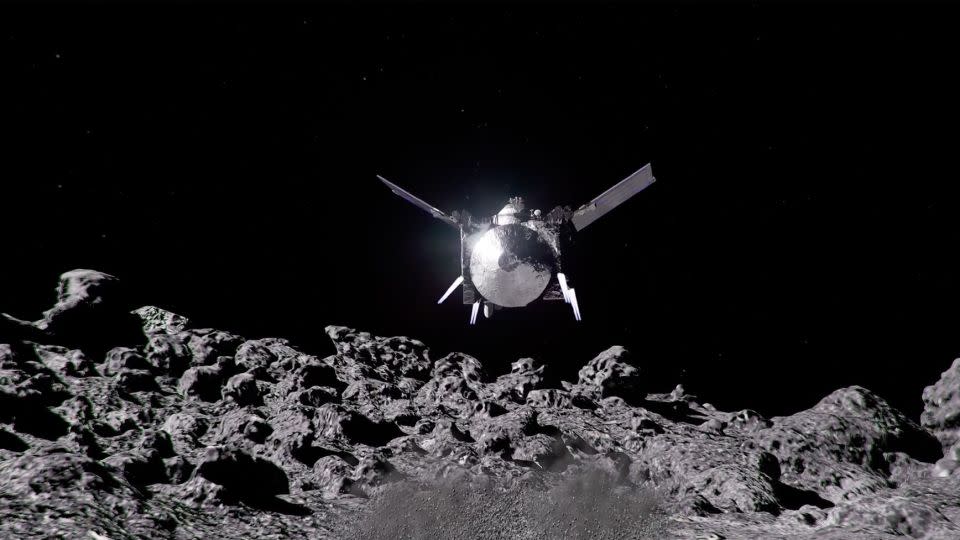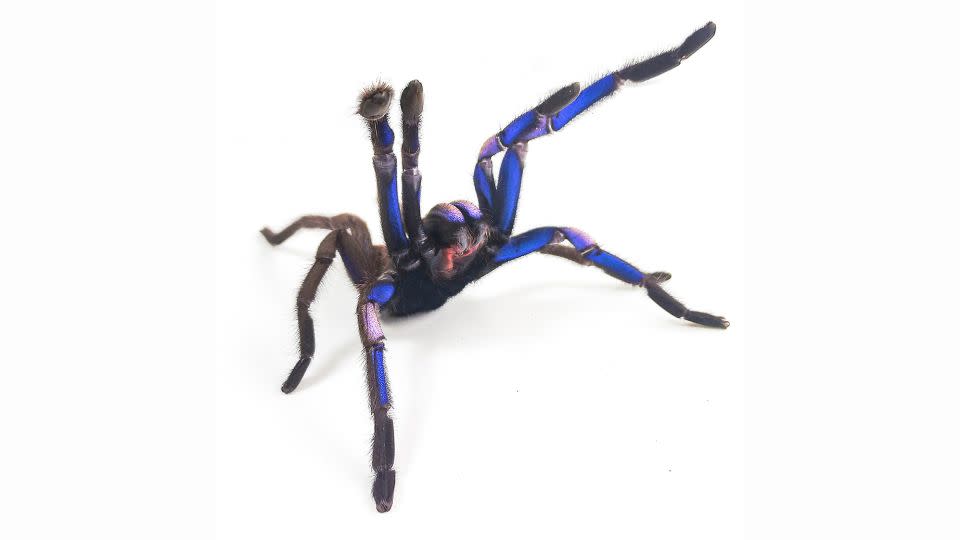NASA’s next stop: An asteroid named for the Egyptian god of chaos

- Oops!Something went wrong.Please try again later.
A version of this story appeared in CNN’s Wonder Theory science newsletter. To get it in your inbox, sign up for free here.
After a nearly 4 billion-mile round trip, the OSIRIS-REx spacecraft successfully delivered NASA’s first asteroid sample to Earth.
The capsule containing rocks and soil, collected from the asteroid Bennu, stuck a perfect landing in the Utah desert on September 24 after blazing through Earth’s atmosphere at blistering temperatures — enough to completely char the outside of the receptacle.
Now, the rare contents are safely stowed at NASA’s Johnson Space Center in Houston, where scientists will study them to help unlock the secrets of our solar system.
Countless people who have worked on the mission for years celebrated the historic achievement, including Queen guitarist Brian May, who also happens to be an astrophysicist and proud OSIRIS-REx teammate.
But the spacecraft’s epic journey isn’t over yet.
Across the universe

The newly renamed OSIRIS-APEX mission is setting a course for Apophis, an asteroid with a fear-inducing reputation.
The space rock — named for the Egyptian god of chaos and darkness — was once considered to be one of the most potentially hazardous asteroid threats to Earth.
Apophis isn’t on a collision course with our planet anytime soon, the latest research has suggested. But the asteroid will come so close to Earth in 2029 that people will be able to see it with the naked eye.
And that’s when OSIRIS-APEX will make its move, going into orbit around Apophis and studying it for 18 months. The spacecraft is no longer capable of collecting a sample, but it will use thrusters to kick up dust and rocks to study Apophis’ stony surface.
Unearthed
Archaeologists were excavating a 2,300-year-old tomb in Israel when they came across what may be the remains of a hetaira, or a courtesan of ancient Greece.
The woman’s cremated remains were found inside a cave, along with a well-preserved bronze folding mirror.
She may have been one of the first Greeks to arrive in the region, accompanying a government official or high general during the Hellenistic Age, or between 323 BC and 30 BC.
Several details about her burial, including the rare pristine mirror, hint at the woman’s origins, and researchers hope to uncover more of her story in the future.
Curiosities

Mysterious “fairy circles,” or dot patterns of barren dirt that appear in dryland grasses, have sparked intrigue for decades since being spotted in Southern Africa’s Namib Desert or the Western Australian outback.
A new atlas, pieced together by scientists in Spain using artificial intelligence, reveals that fairy circles may be present at hundreds of places around the world.
The phenomenon that shapes the circles remains a puzzle, but the global atlas will enable research that could illuminate why the polka-dot pattern appears.
Separately, scientists have predicted that the formation of a massive “supercontinent” could make Earth virtually uninhabitable in 250 million years, wiping out humans and mammals unable to cope with excessive heat.
Defying gravity
NASA astronaut Frank Rubio is finally back on Earth after spending a record-breaking 371 days in space — and his extended stay wasn’t planned.
The Soyuz spacecraft that delivered Rubio and cosmonauts Sergey Prokopyev and Dmitri Petelin for a six-month stint began leaking coolant after space debris likely struck it. A replacement spacecraft docked at the International Space Station in late February, and a fresh crew finally arrived on September 15.
Rubio’s calendar year aboard the orbiting outpost is the longest a US astronaut has spent in zero gravity, and now, he’s readjusting to life on Earth.
“We’re not walking, we’re not bearing our own weight (while in space),” he said, “and so it’ll be anywhere from two to six months before I essentially say that I feel normal.”
Meanwhile, a new film explores the story of astronaut José Hernández, the first former migrant worker to venture to space in 2009 after NASA rejected him 11 times.
Wild kingdom

A newly described tarantula species looks like it would be right at home slinging webs alongside Spider-Man.
The electric blue tarantula, named Taksinus bambus, was found living in tree hollows in southern Thailand last year.
“Blue is one of the rarest colors to appear in nature, which makes blue coloration in animals particularly fascinating,” said Narin Chomphuphuang, a researcher at Thailand’s Khon Kaen University who helped discover the spider.
Researchers believe that the unique structure of the tarantula’s hair, rather than the presence of blue pigments, contributes to the creature’s “mesmerizing” appearance.
Explorations
Get lost in these riveting reads:
— The Nobel Prizes in physics, chemistry, and physiology or medicine will be announced next week, awarding brilliant minds for their research — but the illustrious prizes draw criticism, too.
— Elusive pangolins are the world’s most trafficked mammals, but the recent discovery of an unknown species could help in the fight against the scale-covered animal’s extinction.
— Does gum really sit in your stomach for seven years? Here’s what experts have to say about the old wives’ tale and what really happens when you swallow gum.
— The James Webb Space Telescope detected a building block of life on the surface of Europa, an ice-covered ocean world orbiting Jupiter.
Like what you’ve read? Oh, but there’s more. Sign up here to receive in your inbox the next edition of Wonder Theory, brought to you by CNN Space and Science writers Ashley Strickland and Katie Hunt. They find wonder in planets beyond our solar system and discoveries from the ancient world.
For more CNN news and newsletters create an account at CNN.com

